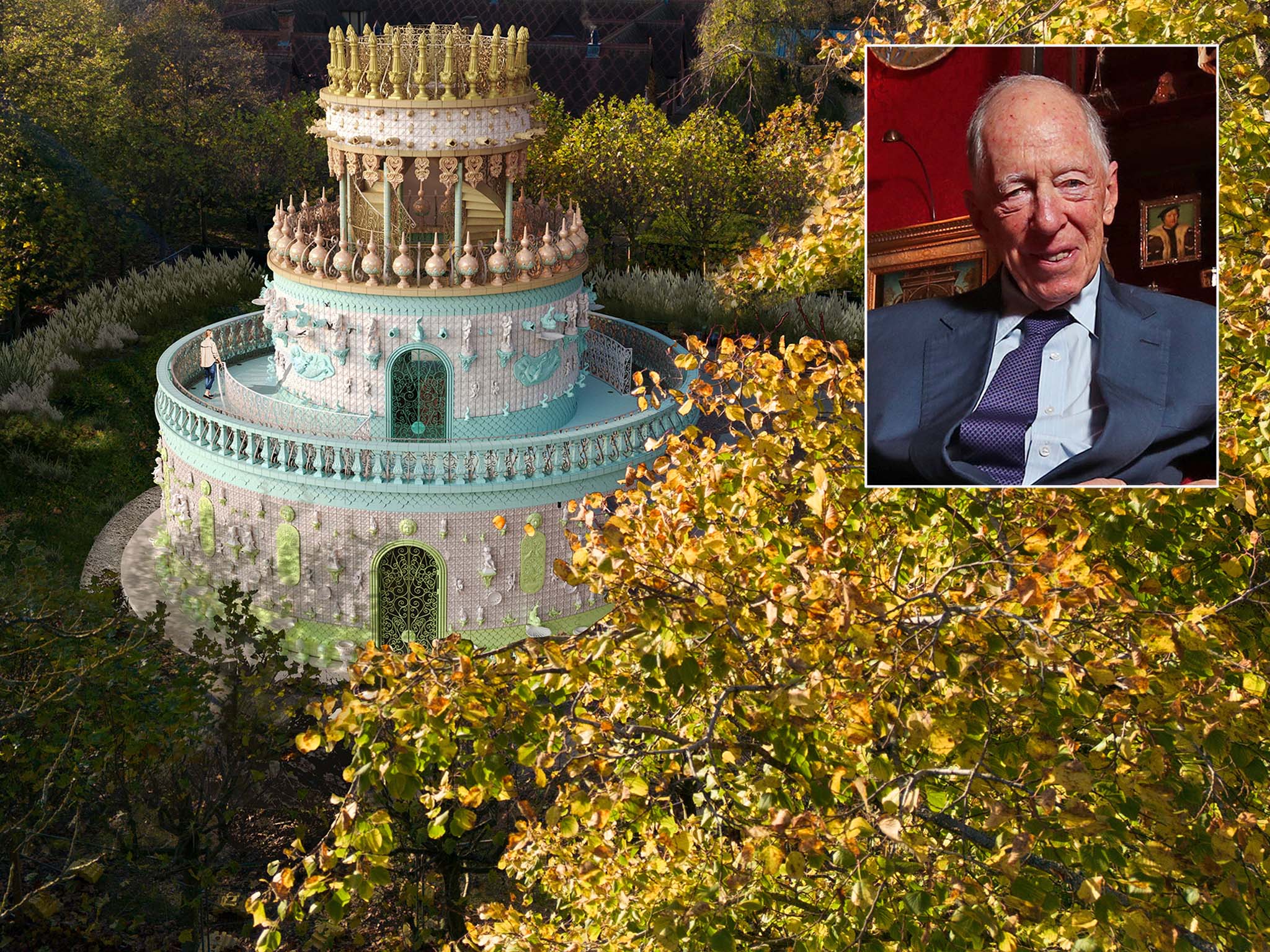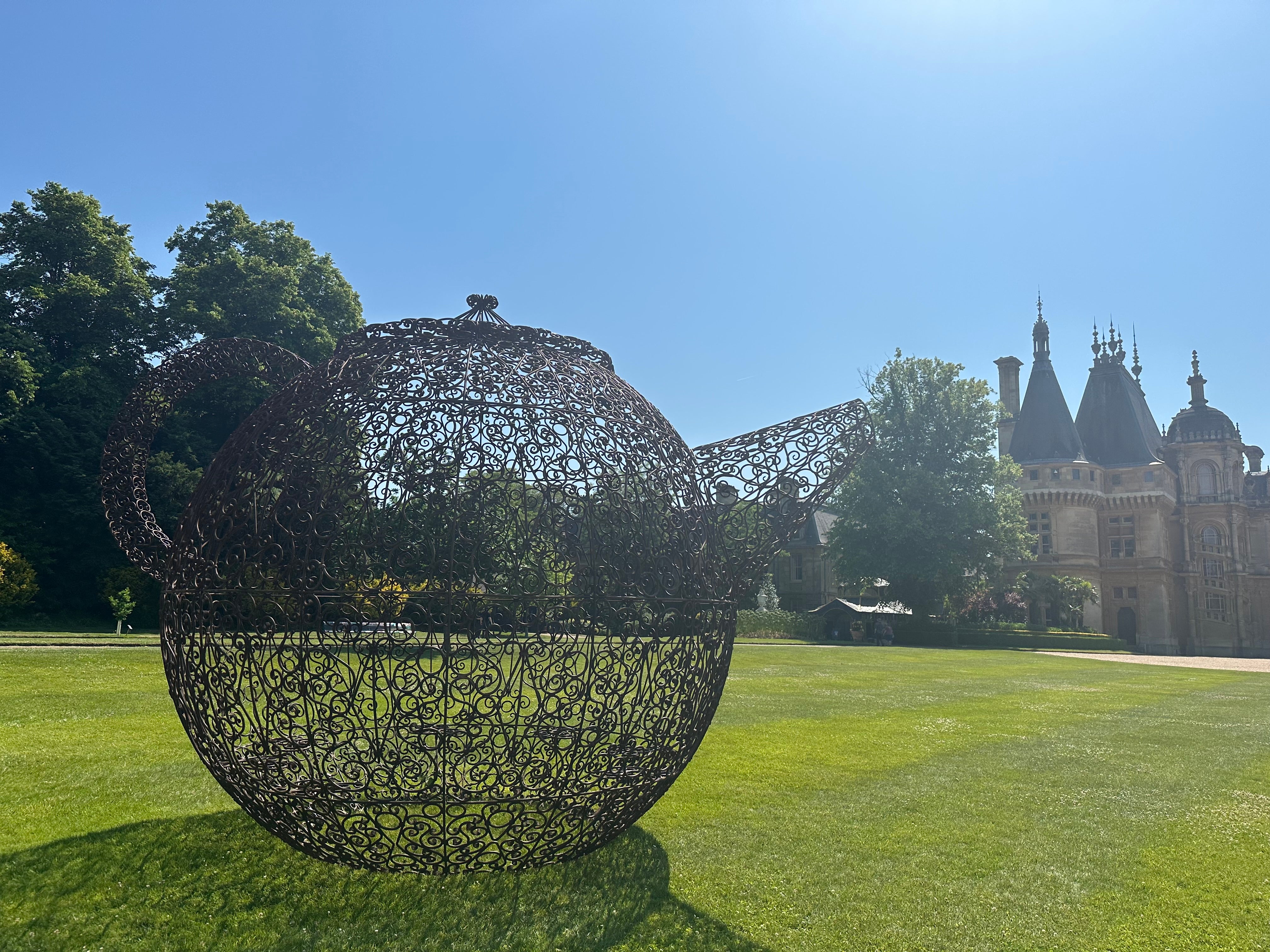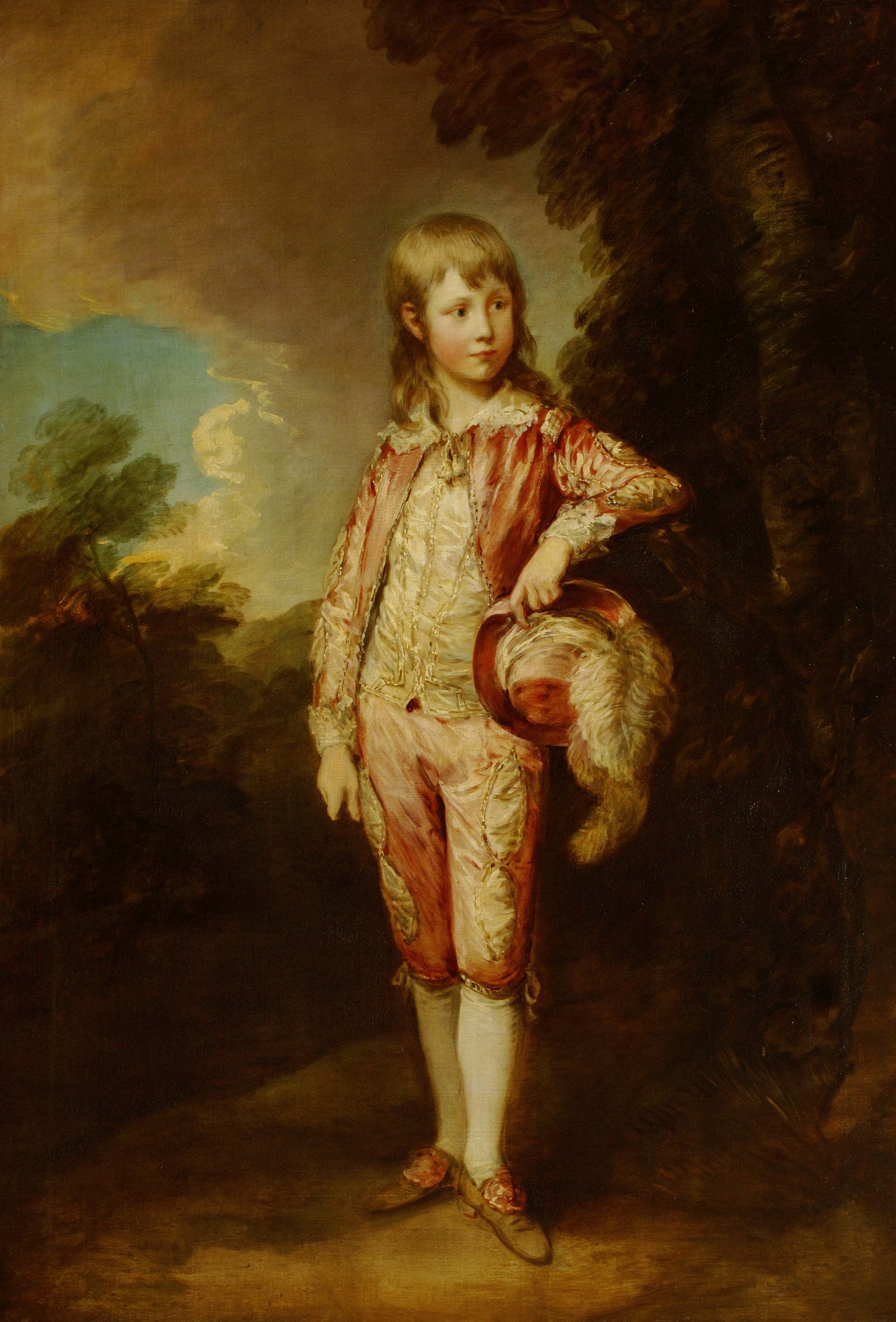Why Britain’s top banker has built a wedding cake in his back garden
As a vast 12m-high wedding cake sculpture – that you can walk inside – is unveiled on the lawn at his stately home Waddesdon Manor, Lord Rothschild, scion of the banking dynasty, tells Geordie Greig about his lifelong passion for collecting, and the time he saved Lucian Freud from the clutches of the Krays


Lord Rothschild’s name is carved in stone on a frieze at the British Museum as a major art patron. Now he has stirred debate in the art world by buying a vast wedding cake for his back garden and it is on show for the public . It is the latest addition to the spectacular old masters at the National Trust house, Waddesdon Manor in Buckinghamshire.
Is it a modern masterpiece or a kitsch piece of fun? You can walk inside it and make your own mind up. He explains why the path of an art patron can lead to gangsters as well as giant teapots.
How did a giant wedding cake end up on your lawn?
I commissioned this wonderful folly, a 12m-high ceramic sculpture in the shape of a cake, which you can walk inside and also enjoy its stunning tiered exterior. Kitsch and beautiful, it has mermaids and electric candles, as well as stairs to the upper tiers of the cake. What could be more fun. I suppose I had a bit of an Alice in Wonderland moment.
Who made the sculpture?
A wonderful Portuguese artist called Joana Vasconcelos, who for 25 years has been updating the arts and crafts concept to the 21st century with irony and humour.
Do you only have a cake?

No, The Manor also has a giant teapot. Made of wire and 9ft tall. I channelled my inner Lewis Carroll to have the tea alongside the cake! Both happen to be superb works of art. They are 21st-century follies for Waddesdon Manor, which had been built by my family in the 19th century on a romantic whim. Joanna had one caste left of the Pavillon de The and I knew I wanted to have one at Waddesdon.
Did your purchases of her work stop there?
Not quite. Joanna had also earlier made artistic towers from champagne magnums and I put the idea to her – because my family are involved with Chateau Lafite Rothschild – that she should make towers of Lafite magnums, and she loved the idea. So we ended up with the magnums outside our house and then the romance of ideas continued and she came forward with the idea of doing this giant wedding cake.

How suitable is this for a stately home?
Very. Waddesdon Manner was built in 1877 by my family and is a kind of folly of follies, a conglomeration of what Baron Ferdinand de Rothschild thought were the best features of the chateaux of the Loire. It is a mad, folly of follies. He then built a dairy, which is another folly, and so this wedding cake is in the grand tradition of Waddesdon.
Why is the ‘Wedding Cake’ open to the public now?
It coincides with the 650th anniversary of the Anglo Portuguese Peace Treaty. The president of Portugal is going with King Charles to a service in the Royal Chapel and then he’s coming straight on down here and is going to cut the ribbon to open the Cake.
So, it’s champagne and tea all the way?
Absolutely, don’t forget Catherine of Braganza who married Charles II was really responsible for bringing tea to England from Portugal.

Is collecting a bit of a family addiction?
I suppose it is, but I can think of worse addictions. Ours is a very extraordinary story really, when I think that the Rothschilds in the middle of the 19th century must have spent the greater part of our lives just buying works of art. I mean Ferdinand built this house after his wife had died and literally every day of his life bought something and created this folly of follies.
‘Wedding Cake’ is your latest purchase but Waddesdon is a treasure house and if you had to save just one object what would it be?
If forced to choose, I would take Chardin’s Boy with the House of Cards. We had no works by Chardin at Waddesdon until one came up for sale in 2011. It fits perfectly with another great masterpiece in the English idiom, The Pink Boy by Gainsborough, which was intended to be shown with The Blue Boy and both were in fact on display for the first time since they were painted at the National Gallery last year.

And if you were allowed a second picture to save?
I think, then, partly for the reasons of sentiment because Ferdinand de Rothschild bought and loved it, I would take The Pink Boy.
You have also added some marvellous portraits of yourself by Lucian Freud and David Hockney to your collection…
Yes, I sat for Lucian Freud partly at a time when I was chairing the National Gallery and he educated me profoundly about old master paintings. I sat for three years between seven and eight in the morning, three times a week, and in most of our time together he would tell me why Velazquez was a great painter or whoever else he liked. I had the most fascinating time with him. It was like having a perfect art professor teaching you art history and sometimes we walked round the National Gallery after hours when it was empty.

Were there odd times with Lucian?
I really met Lucian through his great friend Jane Willoughby and I met him socially once or twice. And then he asked to see me urgently and he said: “Look, I’ve got an appalling problem. I gamble and I owe the Kray twins money. I can’t pay them and they’ve said to me that they’ll cut off my right hand if I don’t pay them by tomorrow. Would you lend me £1,000?” So I said: “Yes, on various conditions. The first is, you never pay it back, and second, you never ask me again.” And he agreed. So I gave him the money. Then a month later an envelope came through my front door and there was £1,000 and he had paid it back. But it was a narrow escape for both of us.
And Hockney…
I don’t remember how we became friendly but anyway he rang me one day and said: “Look, who are you in a relationship with Jacob?” And I said I don’t know that I’m really in a relationship with anybody… except my wife…” He said: “Come on Jacob, you must be in a relationship with someone.” So I said: “My daughter, Hannah.” And then he said he was doing double portraits of people in close relationships. So Hannah and I went down and we spent three or four hours, and the painting is now at Waddesdon.
Tell me about your first art purchase…
I had a stamp collection and I sold it to buy a Giacometti, to my father’s fury. I was lucky. I lived in the basement of a lady who was the widow of the painter Gorky, and she had educated me about Giacometti. A very early nude work of his was available but I didn’t have the money to buy it and so I sold the stamps.

What was the first work of art you were given?
My grandmother, Mary, when I was 11, gave me a small hummingbird painting by Simon Bussy and since then I’ve collected them and I’ve got about 60 of them now. He married Dorothy who was Lytton Strachey’s sister and so part of Bloomsbury. And was related to my grandmother.
Where else have your family been great patrons?
The new library in Israel is a great building by the architects Herzog & de Meuron, which we helped fund, and our family history in terms of buildings there is rather extraordinary because Jerusalem is a city which has changed every decade dramatically. My cousin Jimmy built the Knesset in the Sixties. Then there was the Supreme Court and now there’s the library. So, to have three buildings in Jerusalem through the family foundation is rather an extraordinary achievement.
How varied is your taste?
It’s catholic and promiscuous, for better or for worse. The extraordinary thing is that my family started in the ghetto but by the end of the 19th century they had built 40 houses and they collected like mad. But really the only one left with its collections intact and growing and open to the public, and also telling the history of our family, is Waddesdon. I hope it’s still doing interesting things.

Luck played its part?
Yes, I’ve had this sort of a run of good fortune. At one stage I owned Colnaghi, which has been a leading art dealer for two centuries. I was encouraged by the auctioneer Peter Wilson to sell that and to become involved in Sotheby’s, and for better or for worse I did that and we owned 25 per cent of Sotheby’s. Then this curious thing came about, thanks to Lord Annan, the chairman of the trustees, and Isaiah Berlin, who said I should drop all that and become chairman of the National Gallery. And I was lucky because it was a golden period; we needed money and Paul Getty gave us £50m. We needed a building and Sainsbury’s gave us a building. We needed a new director and, in spite of the civil servants saying they needed previous museum experience as a requirement, we offered the position to Neil MacGregor and persuaded Margaret Thatcher to approve his appointment. It was a brilliant choice. So, I had great strokes of good fortune at the National Gallery.
Collecting is an impulse that does not stop?
I’m afraid so. I mean, I now live in the country and I’m like a child with comics. I look through all the sale catalogues, however obscure they are, in Doncaster or whatever. Occasionally I see things that are interesting.
Any regrets?
I think back to a picture which a French member of my family sold… Vermeer’s The Astronomer, one of the great paintings of the world. But I have to say I feel so lucky to have what I do and regret is not something I ever do.
Joana Vasconcelos: Wedding Cake tours run at Waddesdon Manor from 18 June to 26 October; waddesdon.org.uk/whats-on/wedding-cake-tours






Join our commenting forum
Join thought-provoking conversations, follow other Independent readers and see their replies
Comments